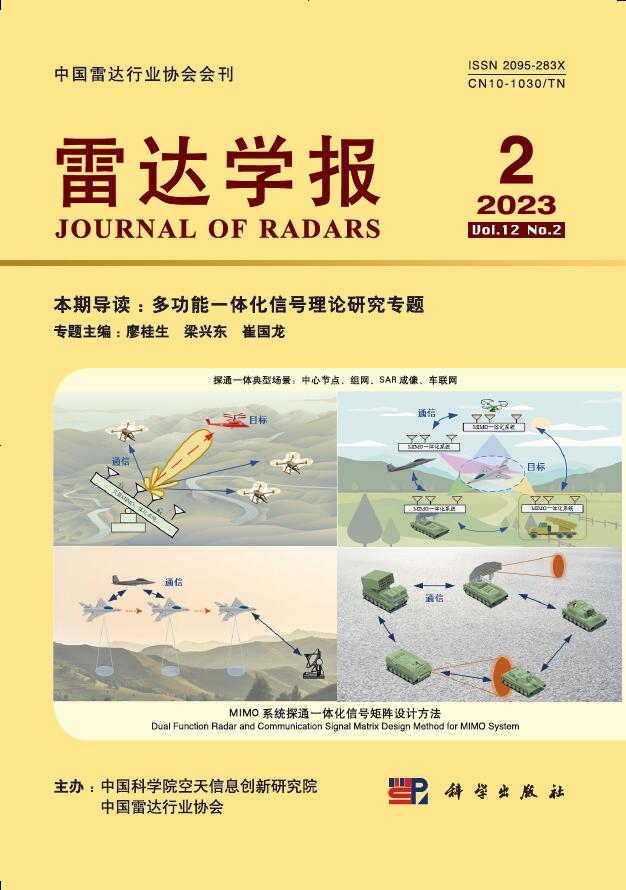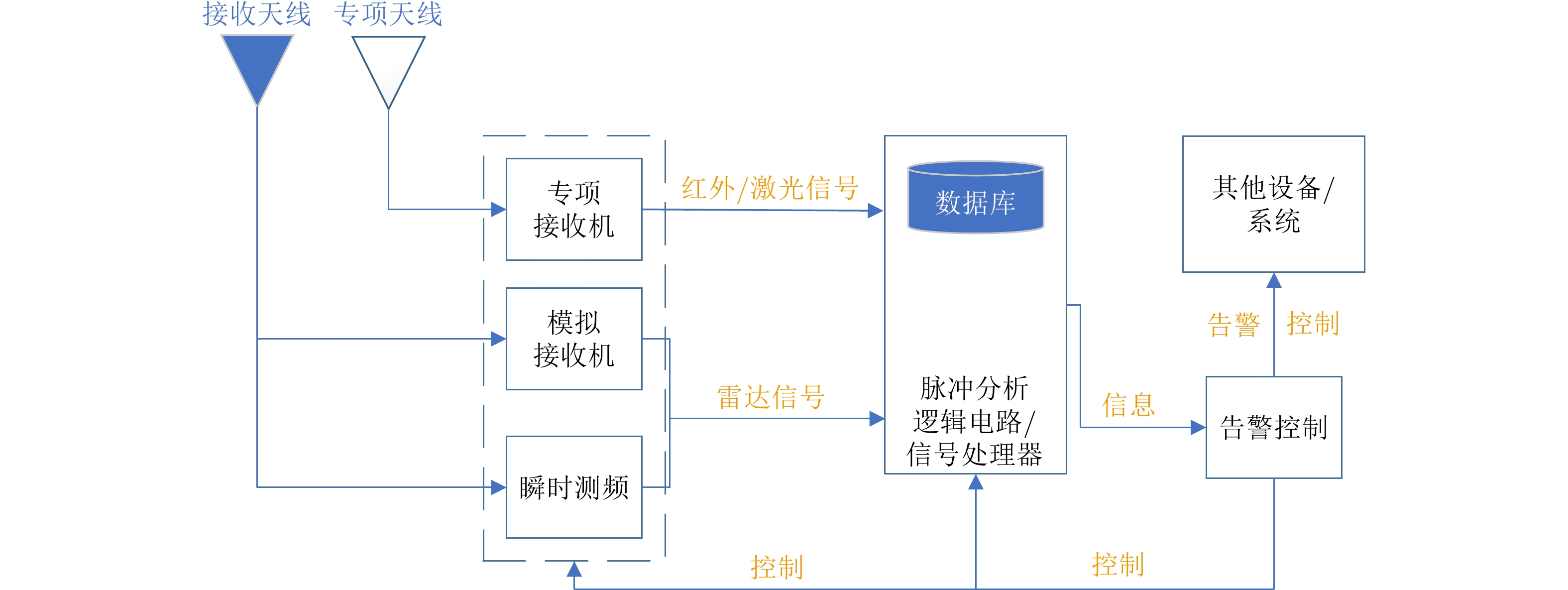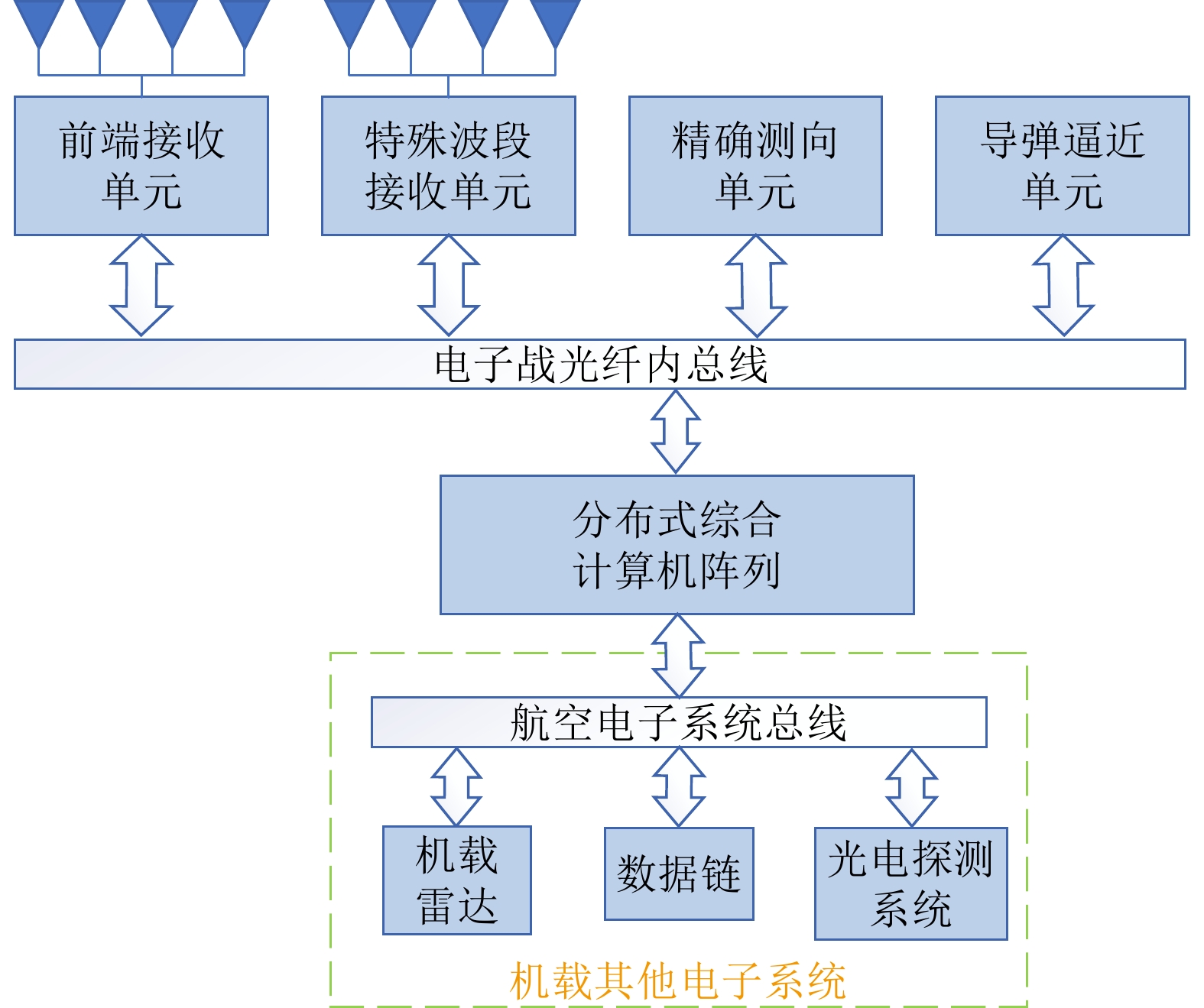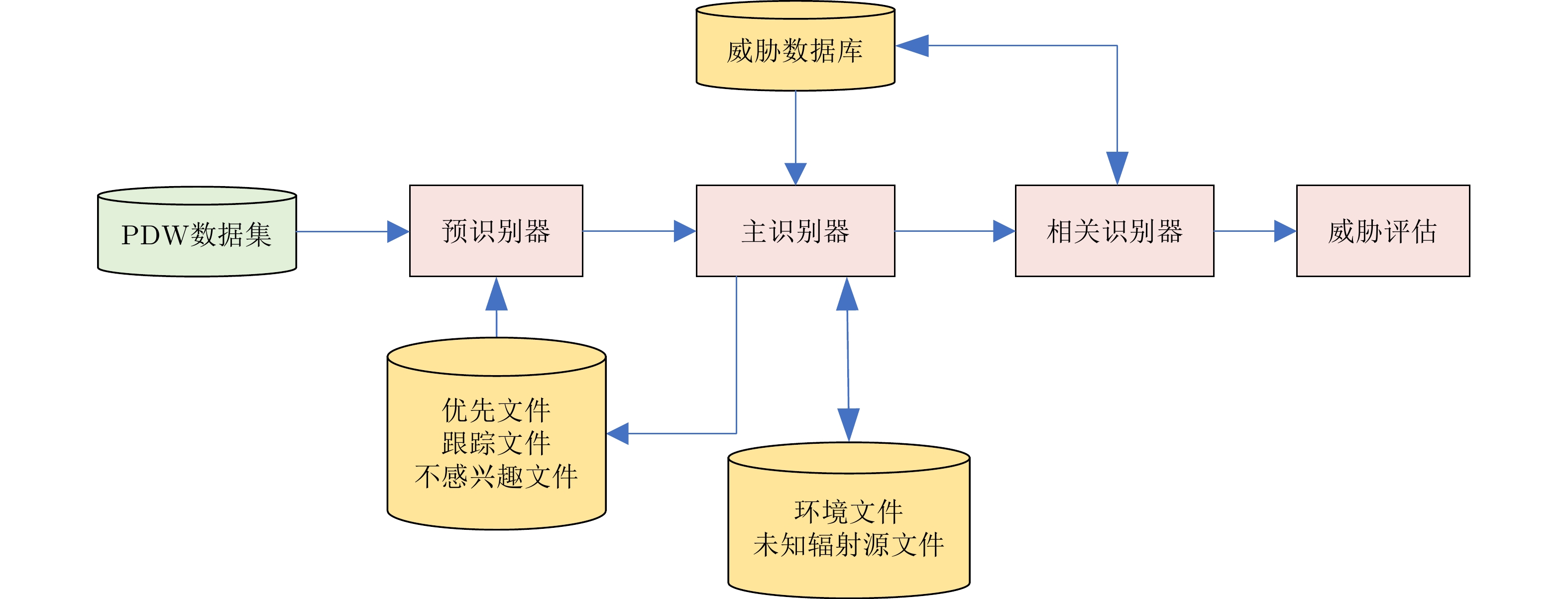| [1] |
LI Zheng. The development trend of the airborne radar warning receiver[J]. Electronic Information Countermeasure Technology, 2008, 23(3): 51–54. doi: 10.3969/j.issn.1674-2230.2008.03.013 |
| [2] |
ZHOU Fan, CHEN Xingkai, HAN Zhuangzhi, et al. The present situation and technical development trend of airborne radar warning receiver[J]. Aerodynamic Missile Journal, 2014(2): 41–46. doi: 10.16338/j.issn.1009-1319.2014.02.010 |
| [3] |
GRANT P M and COLLINS. Introduction to electronic warfare[J]. Communications Radar & Signal Processing Iee Proceedings F, 1982.
|
| [4] |
ZHANG Jinghui, HUANG Xinsong, and WU Zhijian. Campaign targets analysis of airborne self-defense electronic countermeasure equipment[J]. Shipboard Electronic Countermeasure, 2012, 35(6): 10–13. doi: 10.16426/j.cnki.jcdzdk.2012.06.012 |
| [5] |
GAO Song, TENG Kenan, and DUAN Zhe. Analysis on the core EW support equipment and its development trend of the US army[J]. Aerodynamic Missile Journal, 2019(11): 12–17. doi: 10.16338/j.issn.1009-1319.20190114 |
| [6] |
LIU Duqun and GUO Guanyu. Analysis on the development status and trend of Russian electronic warfare[J]. Aeronautical Missile, 2019(10): 16–19. doi: 10.16338/j.issn.1009-1319.20190843 |
| [7] |
ADAMY D L, 王燕, 朱松, 译. EW101: 电子战基础[M]. 北京: 电子工业出版社, 2009: 42–65.
ADAMY D L, WANG Yan, and ZHU Song. translation. EW101: A First Course in Electronic Warfare[M]. Beijing: Publishing House of Electronics Industry, 2009: 42–65.
|
| [8] |
MAINI A K. Battlefield lasers and opto-electronics systems[J]. Defence Science Journal, 2010, 60(2): 189–196. doi: 10.14429/dsj.60.339 |
| [9] |
OSTROWSKI R, CYWIŃSKI A, and STRZELEC M. Electronic warfare in the optical band: Main features, examples and selected measurement data[J]. Defence Technology, 2021, 17(5): 1636–1649. doi: 10.1016/j.dt.2020.09.007 |
| [10] |
鲁旭. 机载雷达告警接收机的发展现状与发展前景展望[J]. 信息通信, 2020(5): 64–65.
LU Xu. Development status and prospect of airborne radar warning receiver[J]. Information &Communications, 2020(5): 64–65.
|
| [11] |
邵超. 雷达发射机和接收机设计[D]. [硕士论文], 西安电子科技大学, 2012.
SHAO Chao. Design of radar transmitter and radar receiver[D]. [Master dissertation], Xidian University, 2012.
|
| [12] |
ADAMY D L, 朱松, 王燕, 译. EW102: 电子战进阶[M]. 北京: 电子工业出版社, 2009: 6–29.
ADAM D L, ZHU Song, and WANG Yan. translation. EW102: A Second Course in Electronic Warfare[M]. Beijing: Publishing House of Electronics Industry, 2009: 6–29.
|
| [13] |
赵国庆. 雷达对抗原理[M]. 2版. 西安: 西安电子科技大学出版社, 2012: 95–100.
ZHAO Guoqing. Principle of Radar Countermeasure[M]. 2nd ed. Xi’an: Xidian University Press, 2012: 95–100.
|
| [14] |
CHEN Yang, CHEN Xinnian, YAN Zhenya, et al. A method of integrated radar signal reconnaissance pretreatment[J]. Modern Radar, 2016, 38(4): 78–81. doi: 10.16592/j.cnki.1004-7859.2016.04.018 |
| [15] |
张永顺, 童宁宁, 赵国庆. 雷达电子战原理[M]. 北京: 国防工业出版社, 2006: 73–78.
ZHANG Yongshun, TONG Ningning, and ZHAO Guoqing. Principles of Radar Electronic Warfare[M]. Beijing: National Defense Industry Press, 2006: 73–78.
|
| [16] |
MARDIA H K. New techniques for the deinterleaving of repetitive sequences[J]. IEE Proceedings F ( Radar and Signal Processing), 1989, 136(4): 149–154. doi: 10.1049/ip-f-2.1989.0025 |
| [17] |
MILOJEVIĆ D J and POPOVIĆ B M. Improved algorithm for the deinterleaving of radar pulses[J]. IEE Proceedings F ( Radar and Signal Processing), 1992, 139(1): 98–104. doi: 10.1049/ip-f-2.1992.0012 |
| [18] |
NISHIGUCHI K and KOBAYASHI M. Improved algorithm for estimating pulse repetition intervals[J]. IEEE Transactions on Aerospace and Electronic Systems, 2000, 36(2): 407–421. doi: 10.1109/7.845217 |
| [19] |
FAN Fuhua, SHI Yingchun, and QIN Lilong. A method for fast detecting sequence with stable pulse repetition interval[J]. Journal of Electronics & Information, in press, 2022. doi: 10.11999/JEIT220127. |
| [20] |
CHANDRA V and BAJPAI R C. ESM data processing parametric deinterleaving approach[C]. TENCON’92 - Technology Enabling Tomorrow, Melbourne, Australia, 1992.
|
| [21] |
WENG Yongxiang, ZHAO Wanlei, and ZHENG Zhijuan. Radar signal sorting algorithm based on PCA combined K-Means clustering[J]. Shipboard Electronic Countermeasure, 2020, 43(2): 38–42, 60. doi: 10.16426/j.cnki.jcdzdk.2020.02.009 |
| [22] |
何佩佩. 被动探测信号聚类分选算法研究[D]. [硕士论文], 中国舰船研究院, 2016.
HE Peipei. Research of passive detection signal sorting based on clustering algorithm[D]. [Master dissertation], China Ship Research and Development Academy, 2016.
|
| [23] |
DONG Baixian and TANG Jianlong. A radar signal online sorting algorithm based on grid-density clustering[J]. Aerospace Electronic Warfare, 2014, 30(6): 45–48. doi: 10.3969/j.issn.1673-2421.2014.06.013 |
| [24] |
LIU Lutao, WANG Lulu, LI Pin, et al. Radar signal sorting algorithm for DSets-DBSCAN without parameter clustering[J]. Journal of National University of Defense Technology, 2022, 44(4): 158–163. doi: 10.11887/j.cn.202204017 |
| [25] |
WANG Xing, CHEN Xiang, ZHOU Yipeng, et al. A radar signal sorting algorithm based on improved DBSCAN algorithm[J]. Journal of Air Force Engineering University ( Natural Science Edition), 2021, 22(3): 47–54. doi: 10.3969/j.issn.1009-3516.2021.03.008 |
| [26] |
李强. 雷达辐射源信号分选技术研究[D]. [硕士论文], 西安电子科技大学, 2019.
LI Qiang. Research on radar emitter signal sorting technology[D]. [Master dissertation], Xidian University, 2019.
|
| [27] |
王嘉慰. 多参数聚类雷达信号分选技术研究[D]. [硕士论文], 哈尔滨工程大学, 2019.
WANG Jiawei. Research on radar signal sorting technology of multi-parameter clustering[D]. [Master dissertation], Harbin Engineering University, 2019.
|
| [28] |
IATSENKO D, MCCLINTOCK P V E, and STEFANOVSKA A. Extraction of instantaneous frequencies from ridges in time-frequency representations of signals[J]. Signal Processing, 2016, 125: 290–303. doi: 10.1016/j.sigpro.2016.01.024 |
| [29] |
BUFLER T D and NARAYANAN R M. Radar classification of indoor targets using support vector machines[J]. IET Radar, Sonar & Navigation, 2016, 10(8): 1468–1476. doi: 10.1049/iet-rsn.2015.0580 |
| [30] |
CAO Ru, CAO Jiuwen, MEI Jianping, et al. Radar emitter identification with bispectrum and hierarchical extreme learning machine[J]. Multimedia Tools and Applications, 2019, 78(20): 28953–28970. doi: 10.1007/s11042-018-6134-y |
| [31] |
WANG Xing, FU Ying, CHEN You, et al. Radar signal recognition based on multi-fractal and semi-supervised EM algorithm[J]. Control and Decision, 2018, 33(11): 1941–1949. doi: 10.13195/j.kzyjc.2017.0799 |
| [32] |
WANG Xing, GUO Pengcheng, TIAN Yuanrong, et al. LPI radar signal recognition based on BDS-GD[J]. Journal of Beijing University of Aeronautics and Astronautics, 2018, 44(3): 583–592. doi: 10.13700/j.bh.1001-5965.2017.0146 |
| [33] |
DUDCZYK J and KAWALEC A. Identification of emitter sources in the aspect of their fractal features[J]. Bulletin of the Polish Academy of Sciences: Technical Sciences, 2013, 61(3): 623–628. doi: 10.2478/bpasts-2013-0065 |
| [34] |
|
| [35] |
BRONSTEIN M M, BRUNA J, LECUN Y, et al. Geometric deep learning: Going beyond Euclidean data[J]. IEEE Signal Processing Magazine, 2017, 34(4): 18–42. doi: 10.1109/MSP.2017.2693418 |
| [36] |
LIN C M, CHEN Y M, and HSUEH C S. A self-organizing interval type-2 fuzzy neural network for radar emitter identification[J]. International Journal of Fuzzy Systems, 2014, 16(1): 20–30.
|
| [37] |
ZHU Mingzhe, FENG Zhenpeng, and ZHOU Xianda. A novel data-driven specific emitter identification feature based on machine cognition[J]. Electronics, 2020, 9(8): 1308. doi: 10.3390/electronics9081308 |
| [38] |
XIAO Zhiling and YAN Zhenya. Radar emitter identification based on novel time-frequency spectrum and convolutional neural network[J]. IEEE Communications Letters, 2021, 25(8): 2634–2638. doi: 10.1109/LCOMM.2021.3084043 |
| [39] |
陈森森. 基于RNN的雷达辐射源分类识别算法研究[D]. [硕士论文], 西安电子科技大学, 2019.
CHEN Sensen. Research on classification and recognition algorithm of radar signal based on RNN[D]. [Master dissertation], Xidian University, 2019.
|
| [40] |
HUANG Kejun, YANG Junan, LIU Hui, et al. Deep adversarial neural network for specific emitter identification under varying frequency[J]. Bulletin of the Polish Academy of Sciences-Technical Sciences, 2021, 69(2): e136737. doi: 10.24425/bpasts.2021.136737 |
| [41] |
高翔. 基于深度置信网络的雷达辐射源识别[D]. [硕士论文], 西安电子科技大学, 2018.
GAO Xiang. Radar emitter recognition based on depth confidence network[D]. [Master dissertation], Xidian University, 2018.
|
| [42] |
YE Wenqiang, YU Zhifu, WANG Hubang, et al. Recognition algorithm of emitter signals based on CNN[J]. Computer Simulation, 2019, 36(9): 33–37. doi: 10.3969/j.issn.1006-9348.2019.09.009 |
| [43] |
王亮. 基于神经网络的雷达信号识别研究[D]. [硕士论文], 哈尔滨工程大学, 2021.
WANG Liang. Research on radar signal recognition based on neural network[D]. [Master dissertation], Harbin Engineering University, 2021.
|
| [44] |
SUN Xia, XU Jingting, JIANG Changmeng, et al. Extreme learning machine for multi-label classification[J]. Entropy, 2016, 18(6): 225. doi: 10.3390/e18060225 |
| [45] |
CHEN Wenbin, FU Kun, ZUO Jiawei, et al. Radar emitter classification for large data set based on weighted-xgboost[J]. IET Radar, Sonar & Navigation, 2017, 11(8): 1203–1207. doi: 10.1049/iet-rsn.2016.0632 |
| [46] |
TANG Xiaojing, CHEN Weigao, XI Longfei, et al. The radar emitter identification algorithm based on Ada boost and decision tree[J]. Electronic Information Warfare Technology, 2018, 33(4): 16–20, 58. doi: 10.3969/j.issn.1674-2230.2018.04.004 |
| [47] |
LIU Yilin, LI Shengyong, LI Weipeng, et al. A radar emitter identification algorithm based on random forest[J]. Electronics Optics & Control, 2022, 29(2): 108–112. doi: 10.3969/j.issn.1671-637X.2022.02.023 |
| [48] |
苏畅. 基于强化学习的雷达辐射源识别技术研究与应用[D]. [硕士论文], 北京邮电大学, 2021.
SU Chang. Research and application of radar emitter recognition technology based on reinforcement learning[D]. [Master dissertation], Beijing University of Posts and Telecommunications, 2021.
|
| [49] |
LENG Pengfei and XU Chaoyang. Specific emitter identification based on deep reinforcement learning[J]. Acta Armamentarii, 2018, 39(12): 2420–2426. doi: 10.3969/j.issn.1000-1093.2018.12.016 |
| [50] |
VISNEVSKI N, HAYKIN S, KRISHNAMURTHY V, et al. Hidden Markov models for radar pulse train analysis in electronic warfare[C]. IEEE International Conference on Acoustics, Speech, and Signal Processing, Philadelphia, USA, 2005.
|
| [51] |
VISNEVSKI N, KRISHNAMURTHY V, WANG A, et al. Syntactic modeling and signal processing of multifunction radars: A stochastic context-free grammar approach[J]. Proceedings of the IEEE, 2007, 95(5): 1000–1025. doi: 10.1109/JPROC.2007.893252 |
| [52] |
欧健. 多功能雷达行为辨识与预测技术研究[D]. [博士论文], 国防科学技术大学, 2017.
OU Jian. Research on behavior recognition and prediction techniques against multi-function radar[D]. [Ph. D. dissertation], National University of Defense Technology, 2017.
|
| [53] |
MA Shuang, LIU Zheng, and JIANG Wenli. The application of gene techniques to multifunction radar signal analysis[J]. Acta Electronica Sinica, 2013, 41(12): 2374–2381. doi: 10.3969/j.issn.0372-2112.2013.12.009 |
| [54] |
ZHANG Kun, KONG Weiren, LIU Peipei, et al. Assessment and sequencing of air target threat based on intuitionistic fuzzy entropy and dynamic VIKOR[J]. Journal of Systems Engineering and Electronics, 2018, 29(2): 305–310. doi: 10.21629/JSEE.2018.02.11 |
| [55] |
ZHAO Ruojing, YANG Fengbao, JI Linna, et al. Dynamic air target threat assessment based on interval-valued intuitionistic fuzzy sets, game theory, and evidential reasoning methodology[J]. Mathematical Problems in Engineering, 2021, 2021: 6652706. doi: 10.1155/2021/6652706 |
| [56] |
HUANG Lida, CAI G, YUAN Hongyong, et al. A hybrid approach for identifying the structure of a Bayesian network model[J]. Expert Systems with Applications, 2019, 131: 308–320. doi: 10.1016/j.eswa.2019.04.060 |
| [57] |
GAO Yang, LI Dongsheng, and ZHONG Hua. A novel target threat assessment method based on three-way decisions under intuitionistic fuzzy multi-attribute decision making environment[J]. Engineering Applications of Artificial Intelligence, 2020, 87: 103276. doi: 10.1016/j.engappai.2019.103276 |
| [58] |
翟翔宇. 基于全连接神经网络的空战目标威胁评估方法研究[D]. [硕士论文], 中北大学, 2020.
ZHAI Xiangyu. Research on threat assessment method of air combat target based on fully connected neural network[D]. [Master dissertation], North University of China, 2020.
|
| [59] |
WANG Yongkun, ZHENG Shiyou, and DENG Xiaobo. Intelligent threat perception of aerial target based on extreme learning machine[J]. Radar Science and Technology, 2020, 18(4): 387–393. doi: 10.3969/k.issn.1672-2337.2020.04.006 |
| [60] |
MA Shidong, ZHANG Hongzhi, and YANG Guoqing. Target threat level assessment based on cloud model under fuzzy and uncertain conditions in air combat simulation[J]. Aerospace Science and Technology, 2017, 67: 49–53. doi: 10.1016/j.ast.2017.03.033 |
| [61] |
ZHANG Caikun, ZHU Zhanxia, FENG Qi, et al. Visualization threat assessment for air combat based on interval-radar chart[J]. Systems Engineering and Electronics, 2016, 38(5): 1052–1058. doi: 10.3969/j.issn.1001-506X.2016.05.13 |
| [62] |
XI Zhifei, XU An, KOU Yingxin, et al. Air combat target threat assessment based on gray principal component[J]. Systems Engineering and Electronics, 2021, 43(1): 147–155. doi: 10.3969/j.issn.1001-506X.2021.01.18 |
| [63] |
HU Tao, WANG Dong, SUN Yao, et al. Air combat threat assessment of improved CRITIC-LRA and grey TOPSIS[J]. Acta Armamentarii, 2020, 41(12): 2561–2569. doi: 10.3969/j.issn.1000-1093.2020.12.022 |
| [64] |
YANG Aiwu, LI Zhanwu, LI Bao, et al. Air combat situation assessment based on dynamic variable weight[J]. Acta Armamentarii, 2021, 42(7): 1553–1563. doi: 10.3969/j.issn.1000-1093.2021.07.023 |
| [65] |
YANG Aiwu, LI Zhanwu, XU An, et al. Threat assessment of air combat target based on RS-CRITIC[J]. Journal of Beijing University of Aeronautics and Astronautics, 2020, 46(12): 2357–2365. doi: 10.13700/j.bh.1001-5965.2019.0638 |
| [66] |
FAN Xiangyu, WANG Hongwei, SUO Zhongying, et al. Radiator threat evaluating method based on rough set and information entropy[J]. Journal of Beijing University of Aeronautics and Astronautics, 2016, 42(8): 1755–1761. doi: 10.13700/j.bh.1001-5965.2015.0663 |
| [67] |
GUO Pengcheng, WANG Xing, ZHOU Dongqing, et al. A grey correlation method based on entropy weight in emitter threat assessment[J]. Journal of Air Force University of Engineering ( Natural Science Edition), 2016, 17(6): 58–63. doi: 10.3969/j.issn.1009-3516.2016.06.011 |
| [68] |
DONG Pengyu, WANG Hongwei, and CHEN You. GRA-TOPSIS emitter threat assessment method based on game theory[J]. Journal of Beijing University of Aeronautics and Astronautics, 2020, 46(10): 1973–1981. doi: 10.13700/j.bh.1001-5965.2019.0543 |
| [69] |
XU Yuheng, CHENG Siyi, and PANG Mengyang. Dynamic radiator threat assessment based on CRITIC-TOPSIS[J]. Journal of Beijing University of Aeronautics and Astronautics, 2020, 46(11): 2168–2175. doi: 10.13700/j.bh.1001-5965.2019.0585 |
| [70] |
ZHANG Ying, WANG Hongwei, and CHEN You. Combined emitter threat assessment based on ICWM-RCM[J]. Systems Engineering and Electronics, 2018, 40(3): 557–562. doi: 10.3969/j.issn.1001-506X.2018.03.11 |
| [71] |
|
| [72] |
GURBUZ S Z, GRIFFITHS H D, CHARLISH A, et al. An overview of cognitive radar: Past, present, and future[J]. IEEE Aerospace and Electronic Systems Magazine, 2019, 34(12): 6–18. doi: 10.1109/MAES.2019.2953762 |
| [73] |
HAYKIN S. Cognitive radar: A way of the future[J]. IEEE Signal Processing Magazine, 2006, 23(1): 30–40. doi: 10.1109/MSP.2006.1593335 |
| [74] |
JIANG Pinghu and SU Pingzhen. On the consideration of the development of airborne electronic warfare technology[J]. Aerospace Electronic Warfare, 2018, 34(2): 56–60. doi: 10.16328/j.htdz8511.2018.02.015 |
| [75] |
GU Kang, LI Yaming, and LIU Ping. Research on the development of intelligent electronic countermeasures equipment[J]. National Defense Science and Technology, 2018, 39(2): 78–81, 90. doi: 10.13943/j.issn1671-4547.2018.02.13 |
| [76] |
王星, 周一鹏, 陈游, 等. 一种采用前后端并行处理机制的机载雷达告警器及其数据处理方法[P]. 中国, 112130141A, 2020.
WANG Xing, ZHOU Yipeng, CHEN You, et al. An airborne radar warning device with front and rear end parallel processing mechanism and its data processing method[P]. CN, 112130141A, 2020.
|
| [77] |
SUTTERFIELD B, HOSCHETTE J A, and ANTON P. Future integrated modular avionics for jet fighter mission computers[C]. 2008 IEEE/AIAA 27th Digital Avionics Systems Conference, St. Paul, USA, 2008.
|
| [78] |
SHAJI R S, DEV V S, and BRINDHA T. A methodological review on attack and defense strategies in cyber warfare[J]. Wireless Networks, 2019, 25(6): 3323–3334. doi: 10.1007/s11276-018-1724-1 |




 Submit Manuscript
Submit Manuscript Peer Review
Peer Review Editor Work
Editor Work





 DownLoad:
DownLoad:



